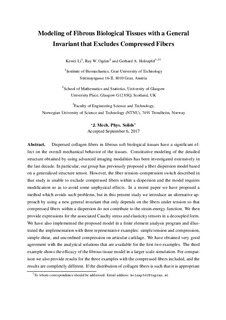| dc.contributor.author | Li, Kewei | |
| dc.contributor.author | Ogden, Ray W | |
| dc.contributor.author | Holzapfel, Gerhard | |
| dc.date.accessioned | 2019-03-06T12:32:22Z | |
| dc.date.available | 2019-03-06T12:32:22Z | |
| dc.date.created | 2018-10-17T10:31:15Z | |
| dc.date.issued | 2018 | |
| dc.identifier.citation | Journal of the mechanics and physics of solids. 2018, 110 38-53. | nb_NO |
| dc.identifier.issn | 0022-5096 | |
| dc.identifier.uri | http://hdl.handle.net/11250/2589002 | |
| dc.description.abstract | Dispersed collagen fibers in fibrous soft biological tissues have a significant effect on the overall mechanical behavior of the tissues. Constitutive modeling of the detailed structure obtained by using advanced imaging modalities has been investigated extensively in the last decade. In particular, our group has previously proposed a fiber dispersion model based on a generalized structure tensor. However, the fiber tension–compression switch described in that study is unable to exclude compressed fibers within a dispersion and the model requires modification so as to avoid some unphysical effects. In a recent paper we have proposed a method which avoids such problems, but in this present study we introduce an alternative approach by using a new general invariant that only depends on the fibers under tension so that compressed fibers within a dispersion do not contribute to the strain-energy function. We then provide expressions for the associated Cauchy stress and elasticity tensors in a decoupled form. We have also implemented the proposed model in a finite element analysis program and illustrated the implementation with three representative examples: simple tension and compression, simple shear, and unconfined compression on articular cartilage. We have obtained very good agreement with the analytical solutions that are available for the first two examples. The third example shows the efficacy of the fibrous tissue model in a larger scale simulation. For comparison we also provide results for the three examples with the compressed fibers included, and the results are completely different. If the distribution of collagen fibers is such that it is appropriate to exclude compressed fibers then such a model should be adopted. | nb_NO |
| dc.language.iso | eng | nb_NO |
| dc.publisher | Elsevier | nb_NO |
| dc.rights | Attribution-NonCommercial-NoDerivatives 4.0 Internasjonal | * |
| dc.rights.uri | http://creativecommons.org/licenses/by-nc-nd/4.0/deed.no | * |
| dc.title | Modeling fibrous biological tissues with a general invariant that excludes compressed fibers | nb_NO |
| dc.type | Journal article | nb_NO |
| dc.type | Peer reviewed | nb_NO |
| dc.description.version | acceptedVersion | nb_NO |
| dc.source.pagenumber | 38-53 | nb_NO |
| dc.source.volume | 110 | nb_NO |
| dc.source.journal | Journal of the mechanics and physics of solids | nb_NO |
| dc.identifier.doi | 10.1016/j.jmps.2017.09.005 | |
| dc.identifier.cristin | 1620976 | |
| dc.description.localcode | © 2017. This is the authors’ accepted and refereed manuscript to the article. Locked until 14.9.2019 due to copyright restrictions. This manuscript version is made available under the CC-BY-NC-ND 4.0 license http://creativecommons.org/licenses/by-nc-nd/4.0/ | nb_NO |
| cristin.unitcode | 194,64,45,0 | |
| cristin.unitname | Institutt for konstruksjonsteknikk | |
| cristin.ispublished | true | |
| cristin.fulltext | postprint | |
| cristin.qualitycode | 2 | |

